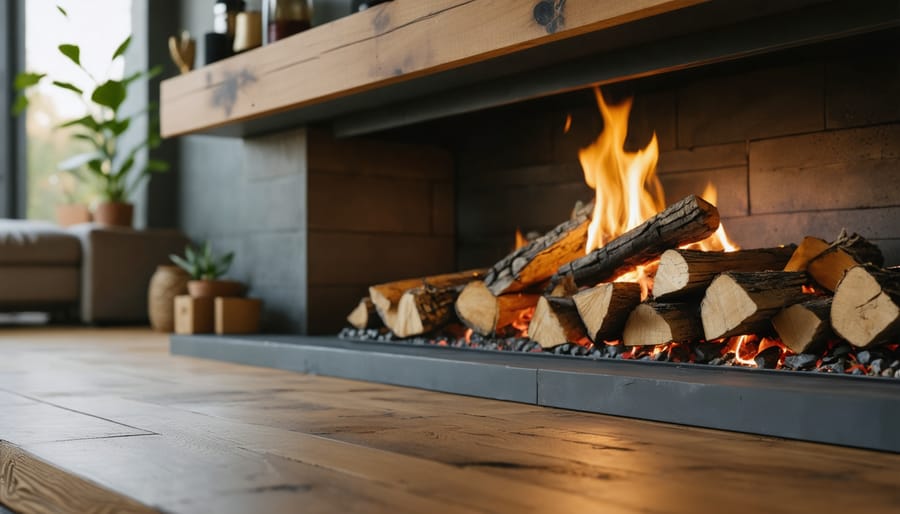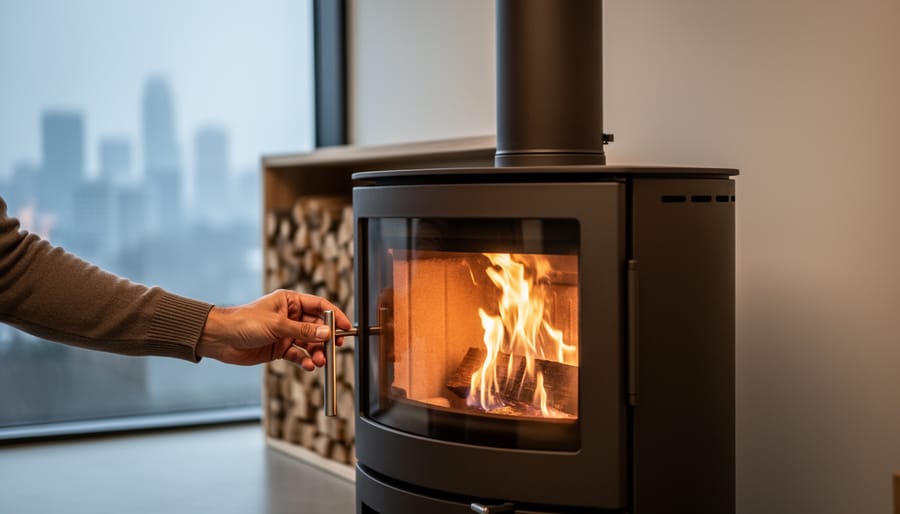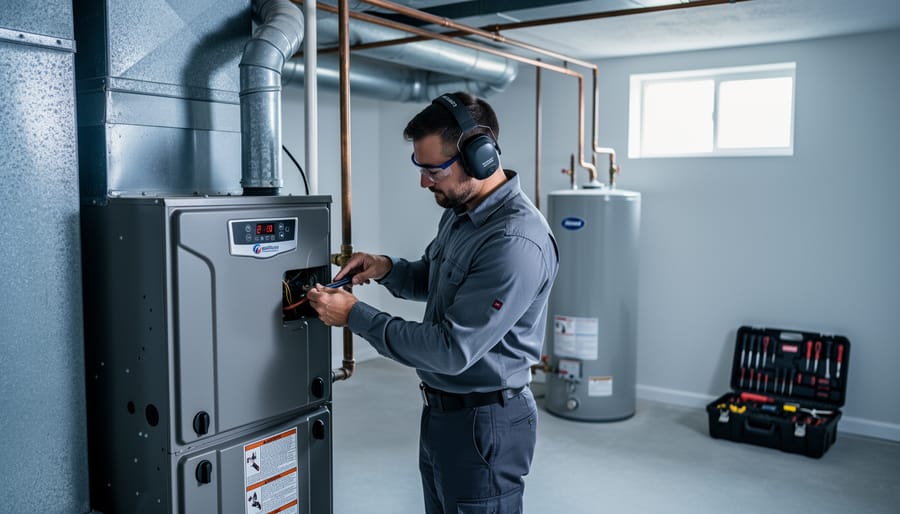Transform your home’s comfort and efficiency with a high-efficiency wood-burning fireplace, the perfect blend of traditional charm and modern technology. Unlike conventional fireplaces that lose up to 80% of their heat through the chimney, these innovative units capture and redirect up to 80% of the heat back into your living space, dramatically reducing fuel consumption while maximizing warmth.
Today’s high-efficiency fireplaces combine advanced combustion technology with elegant design, offering homeowners a sustainable heating solution that doesn’t sacrifice the timeless appeal of a crackling wood fire. With features like secondary burn chambers, air-wash systems for cleaner glass, and precise airflow controls, these units deliver exceptional performance while producing significantly fewer emissions than their traditional counterparts.
As energy costs continue to rise and environmental consciousness grows, high-efficiency wood-burning fireplaces represent a smart investment in both home comfort and sustainability. Whether you’re looking to retrofit an existing fireplace or install a new system, understanding the technology behind these modern marvels will help you make an informed decision that enhances your home’s warmth, value, and environmental impact for years to come.
What Makes a Wood Fireplace ‘High-Efficiency’?
Advanced Combustion Systems
Modern high-efficiency wood burning fireplaces incorporate advanced efficient wood burning technology through sophisticated combustion systems. At the heart of these systems are secondary burn chambers, which revolutionize how wood is burned and heat is produced. These chambers capture and burn wood gases that would otherwise escape up the chimney, significantly increasing the fireplace’s efficiency.
The process begins in the primary chamber where wood initially burns, creating gases and smoke. These byproducts then enter a secondary chamber where they’re mixed with preheated air and ignited again, creating a cleaner, more complete burn. Some models also feature catalytic converters, similar to those in cars, which further break down smoke particles and gases at lower temperatures.
Catalytic converters use a honeycomb-shaped ceramic piece coated with precious metals that help burn off smoke particles at temperatures as low as 500°F, compared to the 1,100°F needed in non-catalytic systems. This dual-combustion approach not only maximizes heat output but also reduces emissions, making these fireplaces both environmentally friendly and cost-effective.
Heat Exchange Technology
Modern high-efficiency wood burning fireplaces employ sophisticated heat exchange systems that dramatically improve their warming capability. At the heart of this technology is a network of heat exchange tubes or chambers that capture and redistribute hot air that would otherwise escape up the chimney. These systems typically feature a double or triple combustion process, where heated air is recirculated through separate channels surrounding the firebox.
The primary heat exchanger usually consists of a series of baffles or tubes positioned above the main combustion chamber. As hot gases rise, they’re forced to travel through these passages, allowing more time for heat transfer to occur. Secondary air channels introduce preheated oxygen to burn remaining fuel particles, while tertiary systems ensure nearly complete combustion.
Many advanced models incorporate built-in blower systems that actively circulate warm air throughout your living space. Some designs feature external air intake systems that draw fresh air from outside rather than using already-heated room air for combustion, further enhancing efficiency. These technological improvements can result in efficiency ratings of up to 80%, compared to traditional fireplaces that typically operate at 10-20% efficiency.
Choosing Your High-Efficiency Fireplace
Insert vs. Built-in Options
When choosing a high-efficiency wood burning fireplace, homeowners typically face two main installation options: inserts and built-in units. Fireplace inserts are designed to fit inside existing masonry fireplaces, making them an excellent choice for upgrading traditional fireplaces without major structural changes. These units effectively transform inefficient open fireplaces into powerful heating systems while maintaining the original fireplace’s charm.
Built-in fireplaces, on the other hand, offer more flexibility in terms of placement and design since they’re installed during construction or major renovations. These units can be positioned anywhere in the home where a proper chimney system can be installed, similar to outdoor wood burning appliances. They’re particularly suitable for new construction or complete room remodels.
Both options offer high efficiency ratings, but your choice will largely depend on your existing setup and renovation goals. Inserts are typically more cost-effective and less disruptive to install, while built-in units offer greater customization options and potentially higher heating capacity. Consider factors like your home’s layout, heating needs, and budget when making your decision. Remember that proper professional installation is crucial for both types to ensure safety and optimal performance.
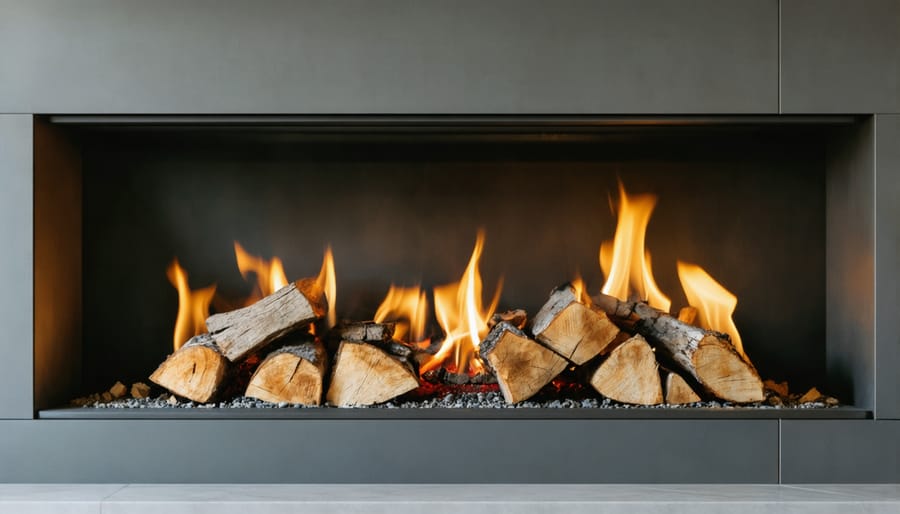
Size and BTU Considerations
Selecting the right size fireplace for your space is crucial for optimal heating efficiency and comfort. A fireplace’s heating capacity is measured in British Thermal Units (BTUs), which indicates how much heat it can generate per hour. As a general rule, you’ll need about 20 BTUs per square foot of living space in a well-insulated home, or 30-35 BTUs per square foot in older or poorly insulated homes.
For example, a 1,000-square-foot area would require a fireplace rated at 20,000-35,000 BTUs, depending on your home’s insulation. However, factors beyond square footage also influence your choice. Consider your climate zone, ceiling height, number of windows, and the fireplace’s location within your home.
High-efficiency wood burning fireplaces typically offer BTU ranges from 30,000 to 80,000 BTUs per hour. While it might be tempting to choose the highest BTU rating available, bigger isn’t always better. An oversized unit can lead to excessive heat and inefficient burning, while an undersized one won’t adequately warm your space.
When planning your installation, also consider the physical dimensions of the fireplace. Ensure you have adequate clearance for safety requirements and that the unit’s size complements your room’s aesthetics. Many manufacturers provide sizing charts and BTU calculators to help you make an informed decision that balances both heating needs and spatial considerations.
Maximizing Your Fireplace’s Efficiency
Wood Selection and Storage
The success of your high-efficiency wood-burning fireplace largely depends on proper wood selection and storage practices. For optimal performance, always use seasoned hardwoods like oak, maple, or hickory, which have been dried for at least 6-12 months. These woods burn longer and hotter than softwoods, providing better heat output and fewer creosote deposits.
Store your firewood in a covered, well-ventilated area that protects it from rain and snow while allowing air circulation. Keep the wood stack elevated off the ground using pallets or a dedicated firewood rack to prevent moisture absorption and insect infestation. Aim for a moisture content of 20% or less in your firewood – you can check this using an inexpensive moisture meter.
Avoid burning treated lumber, painted wood, or green wood, as these can release harmful chemicals and create excessive smoke. It’s best to stock up on firewood during the spring or summer months when prices are typically lower, and you’ll have plenty of time for the wood to season properly before the heating season begins.
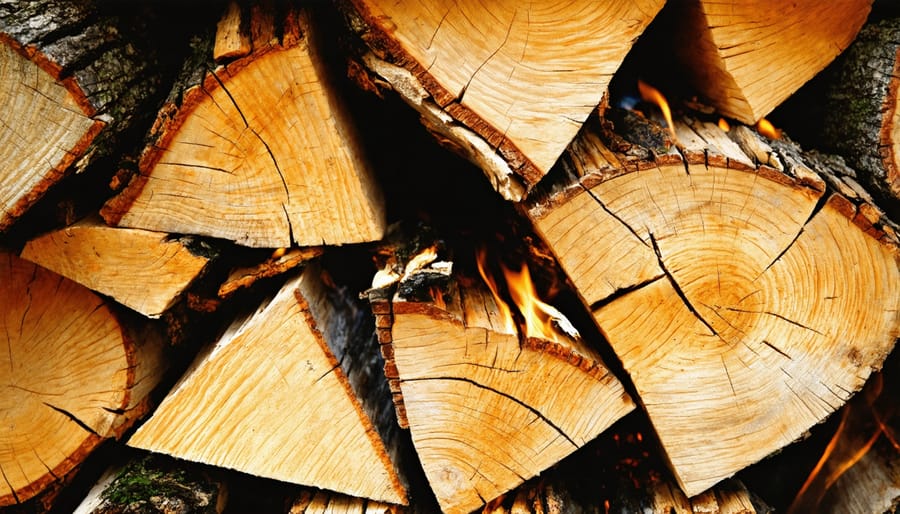
Operating Techniques
To maximize your high-efficiency wood burning fireplace’s performance, start by using only well-seasoned hardwood with moisture content below 20%. Build your fire by placing larger logs at the bottom, followed by smaller pieces and kindling on top. This “top-down” burning method allows for better airflow and more complete combustion.
Control the fire’s intensity by adjusting the air vents rather than closing the glass doors completely. When starting the fire, open the vents fully to ensure proper draft. Once the fire is established, reduce the airflow gradually to maintain optimal burning temperature between 300-400°F (use your fireplace thermometer as a guide).
For extended burn times, add larger logs every few hours and maintain a bed of hot coals. Avoid overloading the firebox, as this can reduce efficiency and create excess smoke. When adding new wood, open the door slowly to prevent smoke spillage, and place logs carefully to maintain proper airflow.
Remember to clean out ashes regularly, leaving about an inch for insulation, which helps maintain consistent temperatures and promotes better burning efficiency.
Maintenance Requirements
To keep your high-efficiency wood burning fireplace operating at its best, following proper regular maintenance procedures is essential. Clean the firebox weekly during the burning season, removing ashes and unburned material. Inspect the door gaskets monthly to ensure a tight seal, which is crucial for maintaining efficiency. Have your chimney professionally cleaned and inspected annually, preferably before the heating season begins.
Check the catalytic combustor every two months during regular use, and clean or replace it as needed. This component is vital for achieving maximum efficiency and reducing emissions. Keep the glass door clean using appropriate cleaners to maintain visibility and detect any burning issues early.
Monitor the firebricks and internal components for signs of wear or damage. Replace any cracked or deteriorated parts promptly to prevent heat loss and maintain safety. Additionally, ensure your wood supply is properly seasoned, with moisture content below 20%, to achieve optimal burning efficiency and reduce creosote buildup.
Remember that a well-maintained fireplace not only performs better but also lasts longer and provides safer operation for your home.
Environmental Impact and Cost Benefits
Emission Reduction
High-efficiency wood burning fireplaces represent a significant leap forward in reducing environmental impact compared to traditional fireplaces. These modern units achieve emission rates that are up to 90% lower than conventional wood-burning fireplaces, making them a more environmentally responsible choice for home heating.
The advanced combustion technology in these fireplaces ensures nearly complete burning of wood and gases, resulting in minimal smoke and particulate matter release. This is achieved through a secondary combustion chamber that burns off remaining gases and particles that would otherwise escape through the chimney. The result is cleaner smoke with significantly reduced levels of harmful pollutants like carbon monoxide and fine particulate matter.
Additionally, high-efficiency fireplaces require less wood to produce the same amount of heat, further reducing their environmental footprint. This improved fuel efficiency means fewer trees need to be harvested for the same heating output. Many models also meet or exceed EPA emissions standards, making them compliant with strict environmental regulations in most areas.
The reduced emissions not only benefit the environment but also contribute to better air quality in your neighborhood, making these fireplaces an excellent choice for environmentally conscious homeowners.
Long-term Cost Analysis
Investing in a high-efficiency wood burning fireplace can yield significant financial returns over time. While the initial cost typically ranges from $3,000 to $7,000 including installation, the long-term savings make it a worthwhile investment. Homeowners can expect to reduce their heating costs by 20-40% compared to traditional fireplaces, which translates to annual savings of $200-600 on average.
The return on investment period usually falls between 5-7 years, depending on your local fuel costs and usage patterns. When comparing fuel costs, wood remains one of the most economical heating options, especially if you have access to low-cost or free firewood sources. A cord of wood, costing between $150-300, can provide heat equivalent to 200 gallons of heating oil or 240 therms of natural gas.
Additionally, high-efficiency units require less frequent maintenance and chimney cleaning, saving approximately $100-200 annually in service costs. The durability of modern units, with lifespans of 20-25 years, further enhances their value proposition. When factoring in potential home value appreciation of 3-5%, these fireplaces prove to be both a practical and financially sound investment for the long term.
Upgrading to a high-efficiency wood burning fireplace represents a significant step toward creating a more comfortable, sustainable, and cost-effective home heating solution. These modern units offer the perfect blend of traditional charm and contemporary efficiency, delivering up to 80% more heat while consuming less wood than conventional fireplaces. By investing in this technology, you’ll not only enhance your home’s ambiance but also reduce your environmental impact and heating costs.
The benefits are clear: superior heat output, lower wood consumption, reduced emissions, and improved safety features make high-efficiency fireplaces an excellent choice for environmentally conscious homeowners. Plus, many models qualify for energy efficiency tax credits and rebates, making the investment even more attractive.
Whether you’re looking to replace an outdated fireplace or install a new one, today’s high-efficiency options provide an unmatched combination of performance and aesthetics. Make the switch to a high-efficiency wood burning fireplace and experience the perfect marriage of traditional warmth and modern innovation in your home.

